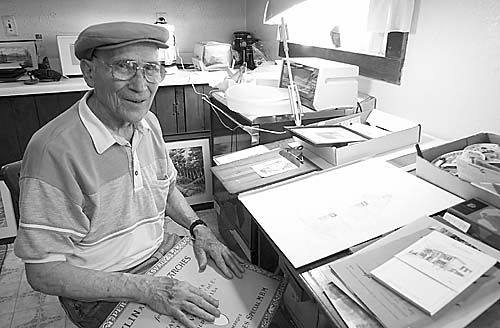“I Never Gave Up the Art”
Boyd Boggs of Gilmer County
Interview by Ginny Hawker
West Virginia is home to a large population of talented artists, working in nearly every conceivable medium. During his long career, 81-year-old Boyd Boggs of Glenville has found a creative outlet in watercolors, glass decorating, sign painting, pencil sketching, and in the skillful pen-and-ink drawings of dozens of historic buildings in Gilmer County, for which he received the 2001 History Hero Award from the West Virginia State Archives and History Commission. And he’s still at it, working steadily from a small studio he has set up in the kitchen of his modest home.
Boyd Averill Boggs was born in 1922 in Roane County, the middle son of James Harley and Ethel Stella McLaughlin Boggs. Older brother George and younger brother James, Jr., both shared Boyd’s interest in art, though neither parent was artistically inclined. When Boyd was nine years old, the family moved to Gilmer County, where his father took a job with a local oil and gas company. They settled in Tanner, where the boys attended a one-room school, and Boyd had his earliest formative experiences as a budding artist.
In December 2001, Tanner resident Ginny Hawker spoke with Boyd about his life and his art. –ed.

Boyd Boggs seated at his art table in the kitchen of his home
on the outskirts of Glenville.
Photograph by Michael Keller.
Ginny Hawker. When you were very young and starting out, were there people saying, “Oh, stop doing that drawing and go outside and play ball, or something?” Or were you encouraged to do your art?
Boyd Boggs. I was encouraged occasionally. I can’t remember what really got me started. I must have seen something somewhere, or somebody doing artwork at that time. By the time I was in the sixth or seventh or eighth grade, [we were in] this one-room school. There’s a lot of time in there that school kids didn’t have anything to do, you know. But I kept doing little sketches. My older brother [and I], we got into the birds. We had this one-room school lined completely with different birds all in color – watercolor, at that time. We had no training except what we did ourselves, you know. He gave up the art thing, but I kept hanging in.
GH. Are either one of your brothers still living?
BB. My youngest brother, yeah. And he does some artwork. He does old houses and barns and things for people on saws.
GH. Your mother had how many children?
BB. Four. One boy – the first one – lived only about a year, I guess.
GH. Then she had three more boys?
BB. Right.
GH. And all three of you really were interested in some phase of art?
BB. Yeah. Maybe one starts and gets going on it, the other wants to do it, too. All three did some artwork.
GH. How did your mom and dad feel about that?
BB. Oh, they didn’t think of it being too unusual, or anything. I don’t know. I can’t find anyone on either side of the family that was interested in art.
GH. What did your dad do?
BB. He was oil and gas. At that time, the South Penn Oil Company, the same company that exists now.
GH. Did you have a teacher somewhere along the way that encouraged your work?
BB. The only one I think of was at grade school where we did the birds around — Bill Wagner. He encouraged us to do that. I’m sure he did, because they probably wouldn’t have approved of it – the county board – if they knew. But he let us spend an awful lot of time doing that.
GH. In those one-room schools, while they were teaching the other grades, well, your grade had to do something.
BB. We did. Yeah. I don’t know whatever happened to all those drawings. You could sit in there and see all of them up above the windows. That would be nice to find those, wouldn’t it?
You can read the rest of this article in the Fall 2003 issue of Goldenseal, available in bookstores, libraries or direct from Goldenseal.